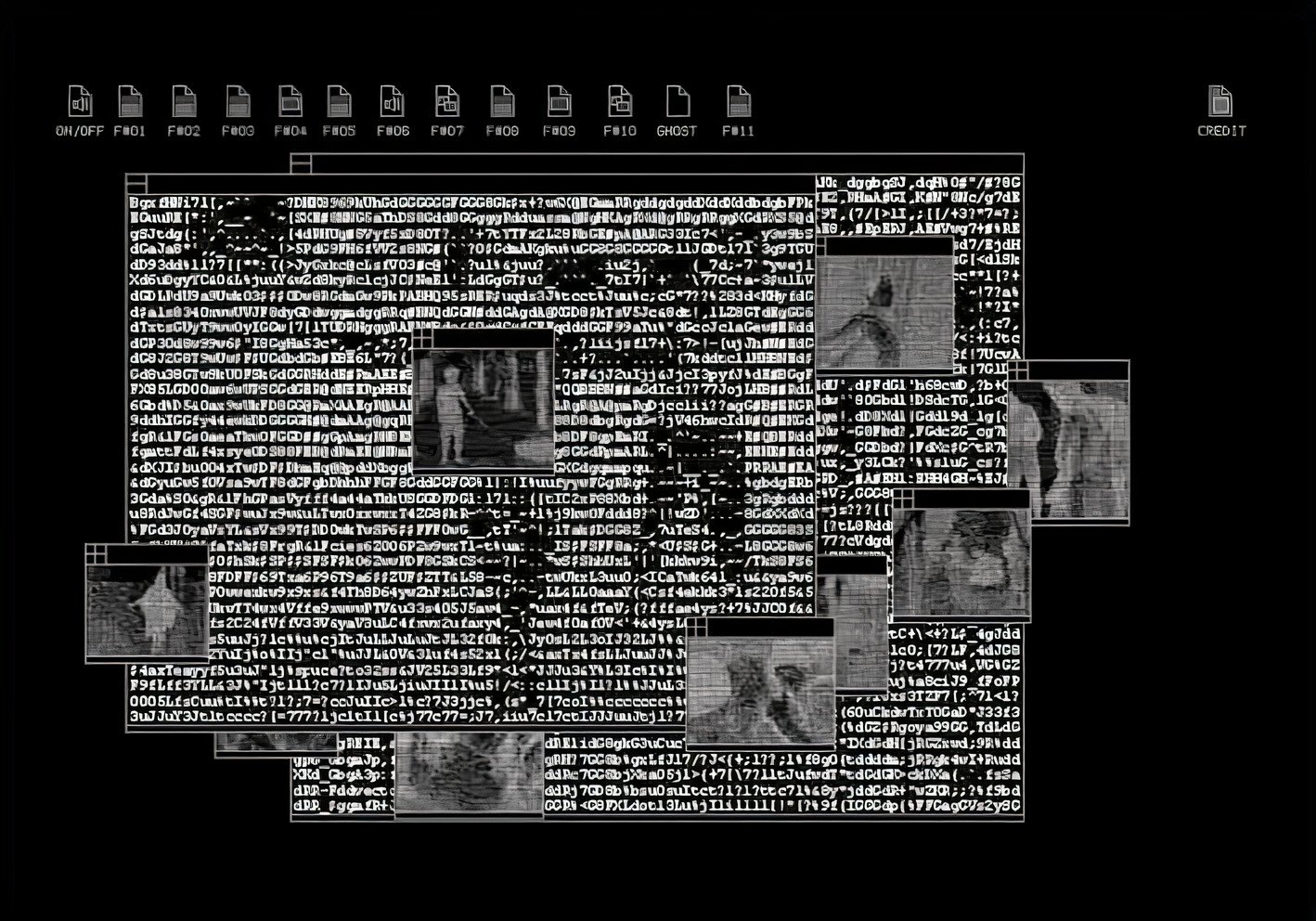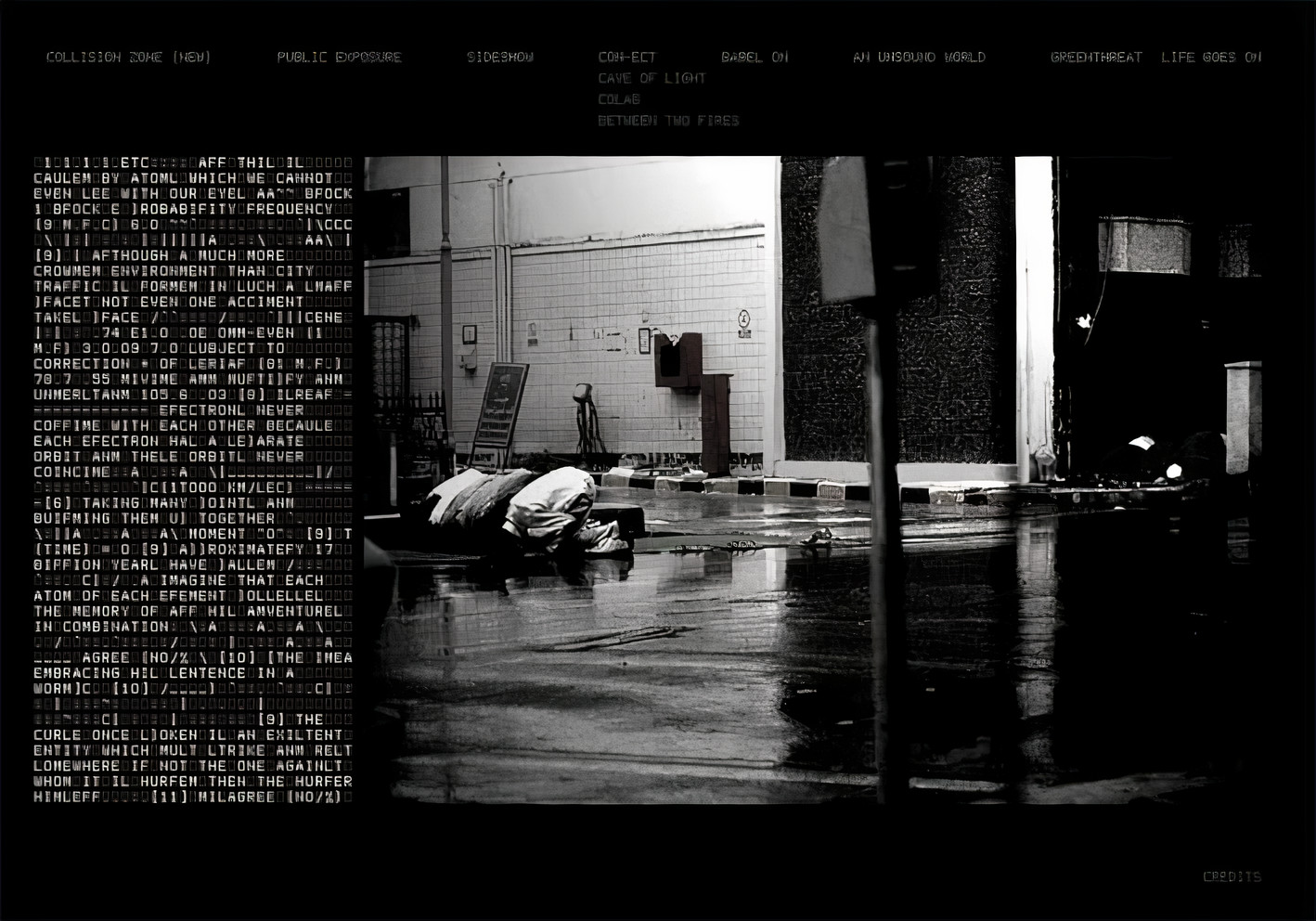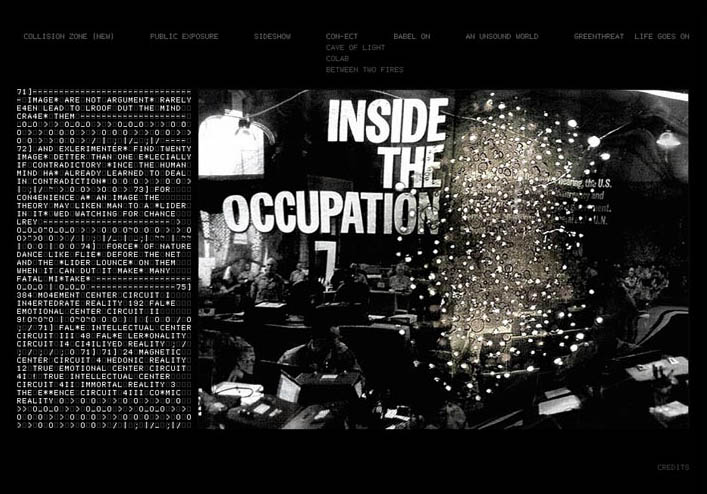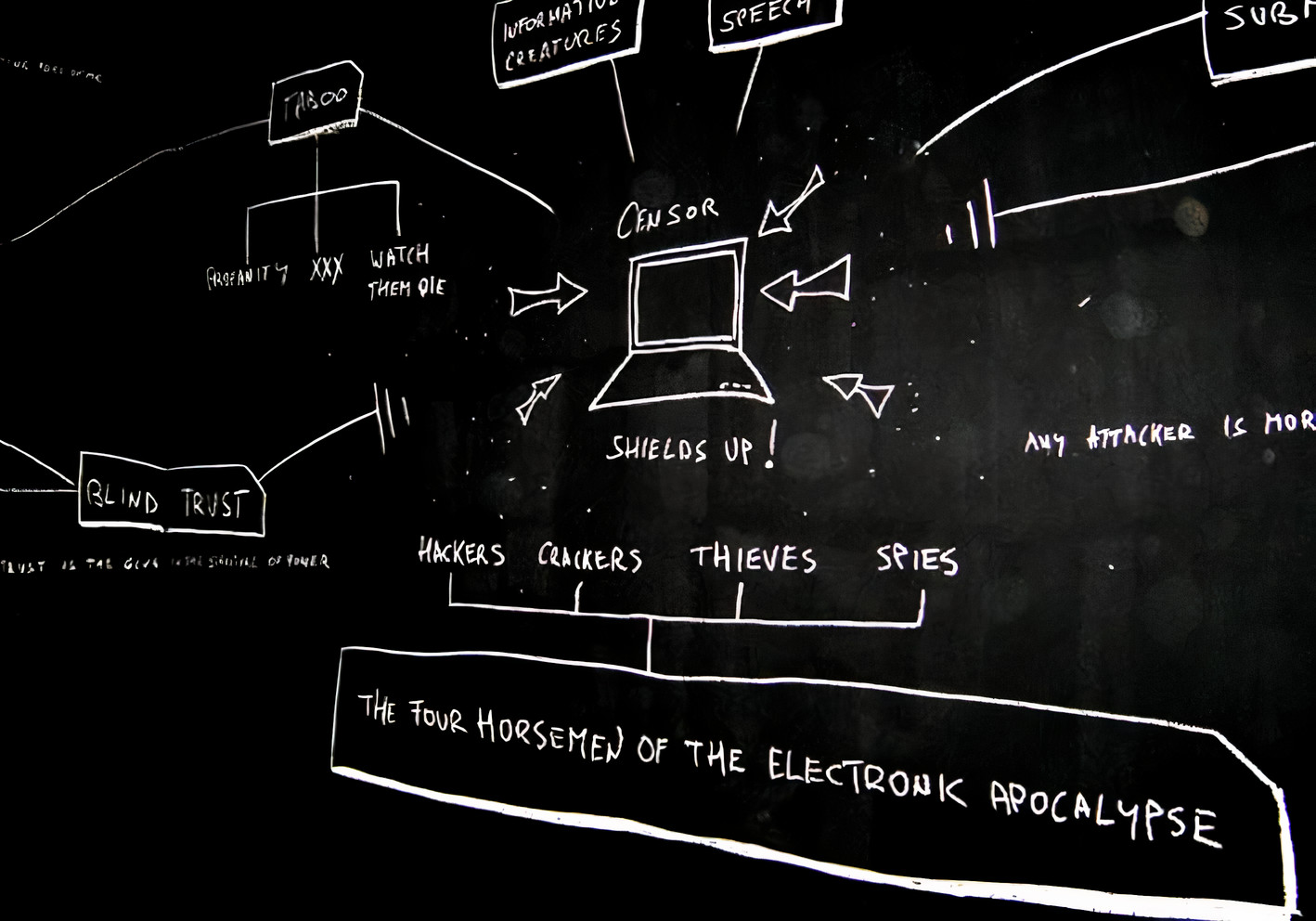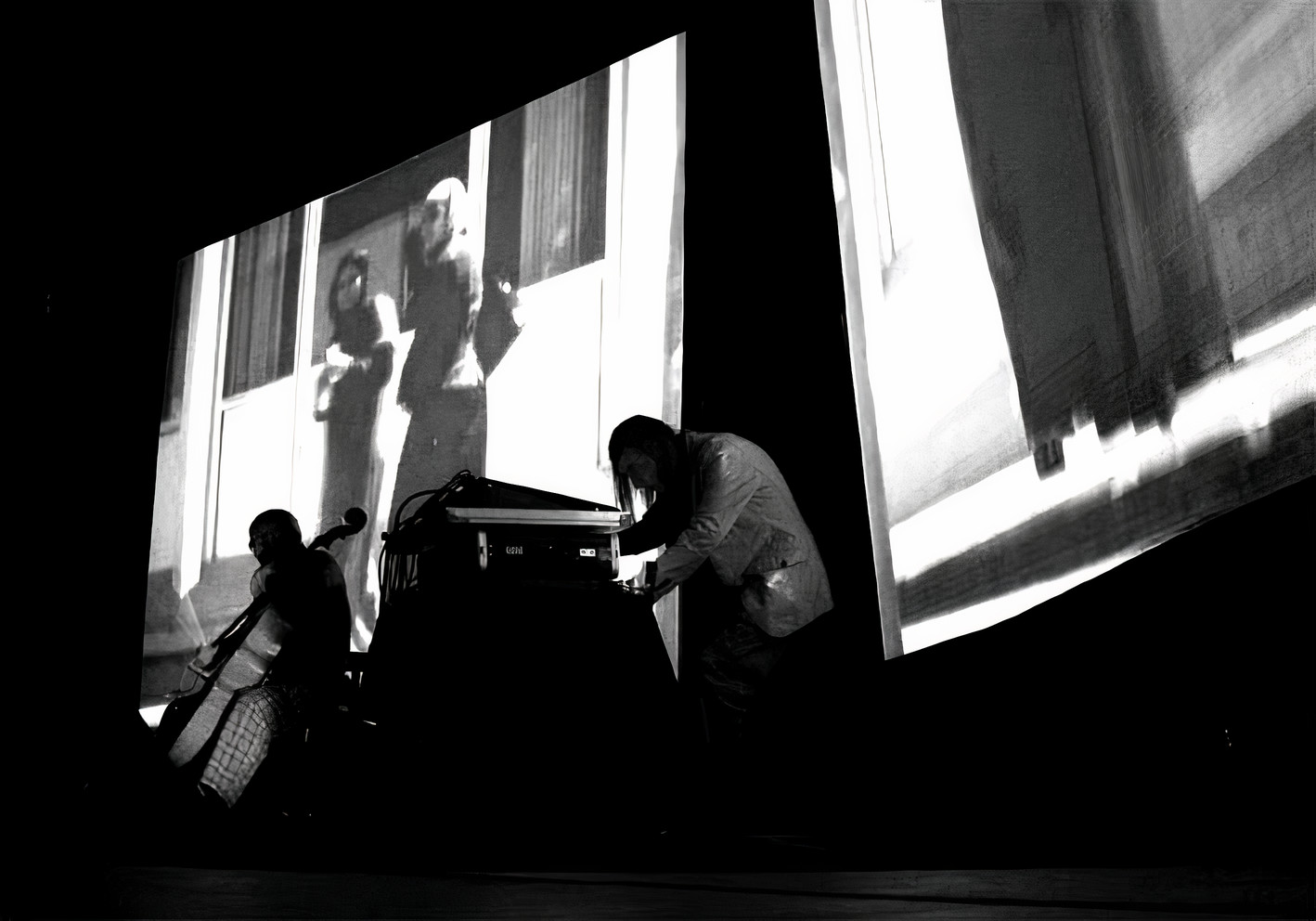THE TRUSTFILES
THE TRUSTFILES
– since 2001
In collaboration with web architect Xavier Massaut.
SR-Medienkunstpreis 2002 awarded to The Trustfiles
https://www.sr.de/sr/home/der_sr/so_engagieren_wir_uns/preise/medienkunstpreis_preistraeger102.html
Nadine Hilbert and Gast Bouschet’s The Trustfiles questions perceptual ambiguities and written-word-impartialities to dismantle codes of power where words conceal and reveal. Words are scraped from websites to construct the project’s own database. Drawing upon mystical tradtitions combining letters and numbers of sacred texts to move beyond the literal, the project mixes the visual and auditory, prompting the user to investigate incomplete transmitted information imbedded in the project. Moreover, the project poses questions about trust in data processing.
(Thinking Through Digital Media: Transnational Environments and Locative Places, 2015
D. Hudson,P. Zimmermann)
What you see below are excerpts from Prophetic Code, which served as the front page for The Trustfiles. You can watch the entire video here
Leonardo Electronic Almanac
Poetry has entered the digital realm, and has been changed by the experience. No longer composed of just static texts on a page or the language that makes up these texts, contemporary poetry has undergone some intense re-wiring at the hidden levels of pixel and sub-text machinery. In this situation, we deal with an expanded notion of “poem” as praxis of surface level and sub-textual computer code levels, and an expanded awareness of the digital poem as process…
The Trustfiles demonstrates a political engagement with multimedia. Featuring text, photography, video, and a participatory interface that varies throughout, The Trustfiles takes a paradoxically mystical view of political action by transubstantiation of documents from interventions and from the web itself into a beatific homage to networked consciousness. Most importantly, Hilbert and Bouschet’s project demonstrates a constant performative oscillation between text and code structure in which fragments of news are reported and then obscured or garbled by intervening code. The result is a kind of beautiful chaos.
(Tim Peterson, New Media Poetry & Poetics Gallery, The International Society for the Arts, Sciences and Technology, MIT Press 2006)
Mundo Urbano, Laboratorio de Hiperrealidad, 2007
The Trustfiles is a collaborative piece by Nadine Hilbert and Gast Bouschet. It is an ongoing process, updated periodically with new content, on which various artists have collaborated. The Trust project was awarded the 2002 SR-Medienkunstpreis. The Trustfiles presents a reduced platform that provides a way of accessing groups of works that analyze different aspects of contemporary society using a variety of artistic approaches. For the most part, the works are audiovisual, however we also find photography, sound, recordings of interventions in the manner of slideshows and animated pictures in ASCII code.
In The Trustfiles the artists record the results of an exploration in search of languages suitable for the task of rendering a variety of different thought processes related to a single general topic. In a section of photographs accompanied by audio, we explore a compilation of different images dealing with the same subject: religious fervour from the perspective of imperialistic power structures. A wealth of allusions to religious symbols and beliefs – crosses, prayers, and biblical messages printed on t-shirts, placards, billboards or walls – are mixed together with commercial catch-phrases and religious sermons. Along similar lines, the photographic recording of an intervention confounds us with diagrams of power structures, hierarchies and logical sequences, such as the depiction of multiple types of relationships (flows) among social agents. In another section, a collection of expressions of prejudice recorded from radio programmes holds up a dark mirror to the mass media. The section reveals how power mechanisms wield strategies of suggestion in order to dominate the masses.
The phrase ‘Trust is the glue in the structure of power’ which appears in one of the many parts of this immense work, succinctly sums up the driving force running through the piece.
Josée Hansen (d’Land): ‘Where Trust still means something-Bank of Utah’ dit une pancarte que tu as photographiée aux Etats-Unis – L’Utah étant l’Etat des mormons… La déclinaison des croyances, des représentations d’un hypothétique dieu est comme le fil rouge du travail que tu publies dans le projet en ligne The Trustfiles et qui provient des quatre coins du monde. J’y lis une critique d’un certain impérialisme religieux… Vrai ou faux?
Gast Bouschet: ‘Trust’ reflète aussi bien la notion de confiance que celle de contrôle et de domination qu’un groupement puissant peut exercer. On peut sans doute lire notre travail comme une critique de monopoles de pensées. Cette critique ne se résume pourtant pas à l’impérialisme religieux, même s’il a certainement joué un rôle de taille dans la propagation excessive de vérités finalement très subjectives. Mais la pancarte ‘where trust still means…’ par exemple n’a pas été réalisée pour promouvoir la foi religieuse mais dans un contexte économique. Même si dans l’Utah religion et économie sont intimement liés, cela reste quand même une publicité pour une banque.
En fait ce qui nous intéresse le plus, c’est de révéler l’ambiguïté de la perception et de mettre en doute l’impartialité du verbe. Toute information visuelle, sonore ou textuelle est toujours lacunaire et dissimule autant qu’elle révèle. On essaie de mettre l’accent sur les bords de la perception, d’investiguer des conflits existentiels et surtout de se perdre dans le tournoiement de l’angoisse et de l’extase que procure chaque confrontation intensive avec le monde et soi-même.
JH: Justement, surfer dans les Trustfiles m’est apparu comme une déambulation dans la polysémie du monde, où rien que le mot ‘trust’ peut avoir toutes ces significations – confiance, espérance, structure du pouvoir économique – mais où de nouveaux liens apparaissent, des questions se posent par l’agencement textes/images/musique. Comme un voyage, mais un voyage ‘organisé’… Comment, selon quels critères se font ces compositions?
GB: La perturbation et la relecture sont essentielles. La stratégie qu’on utilise s’inspire des expériences des mystiques, qui par des combinaisons expérimentales de lettres et de chiffres des textes sacrés essaient de se rapprocher de l’essence même de Dieu. Leur méthode sert à dépasser le sens littéral des mots pour atteindre une autre réalité, enfouie comme un code, à l’intérieur de ces textes. On essaie de s’approcher d’une façon similaire des systèmes de pouvoir. On s’approprie leurs phrases et leurs symboles et on les transforme par l’expérimentation artistique. On réagit ainsi à la profonde crise de perception du monde que nous sommes en train de vivre. L’image du monde devient de plus en plus hallucinatoire.
(extraits d’un entretien électronique avec Josée Hansen publié dans ‘d’Land Kultur’ 27 février 2004)
GHOST
Camouflage Brussels, the European Satellite of the Center of Contemporary Art of Africa, 2005.
An exhibition based on the Trustfiles, which served as a prologue to my participation in the Luanda Biennale in Angola. The showroom was painted dark grey and sparsely decorated with bumper stickers on which I had printed occult maps of Washington D.C. that I had downloaded from conspiracy websites and which were supposed to refer to the Deepstate as well as some other difficult to decipher motifs that pointed to secret military interventions. On the floor, a black balloon was moving in the draught of passing visitors, constantly threatening to explode if anyone stepped on it, and on which I had printed the encrypted blueprint for a bomb that I had also downloaded from the internet. A video I had shot was projected on a wall showing abandoned financial districts at night and air traffic above. A poster showed the photo of the blank wall from which I had retouched the figure that had become the symbol of the Abu Ghraib torture scandal, and in front of it on the floor was a sculpture of the same hooded man I had made. However, the main part of the exhibition took place in the basement of Camouflage, which was closed to the public but could be heard loudly in the upper exhibition space. The soundtrack consisted of recordings made in the basement itself as I walked through the glass-filled cellar. These sounds were mixed with radio recordings commenting on the US military intervention in Iraq and Abu Ghraib, as well as field recordings I had made in Egypt, South Africa and Ghana, which were mainly religious in nature, dealing specifically with the Egyptian Muslim Brotherhood and the American-style commercial evangelicalism that is sweeping Africa.
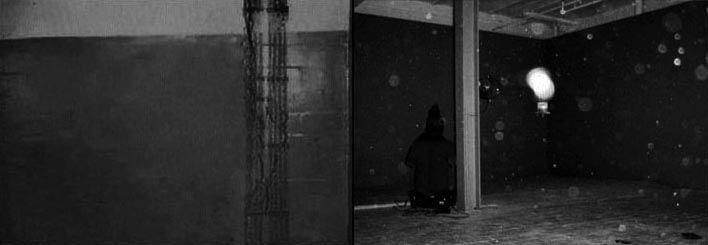
Ghost, poster and installation view.
The tense, threatening atmosphere in the exhibition space is difficult to capture in images and words. A thick layer of dust covering the floor and swirling in the air as visitors walked through the room added significantly to the discomfort of being in that space. Most visitors didn’t know what to make of it, and their reactions varied between dismay at the seriousness of the political issues raised and embarrassed disgust at the prevailing atmosphere and the black humour, which some suspected but found inappropriate. It was one of my most controversial exhibitions, and the reactions to it strengthened my resolve to bring my satanic political approach, which until then had seemed rather subliminal, to the fore. Radical art does not need to be unanimously celebrated, and seeing the dust on the floor vibrate to the rhythm of the sounds from the basement was celebration enough for me.
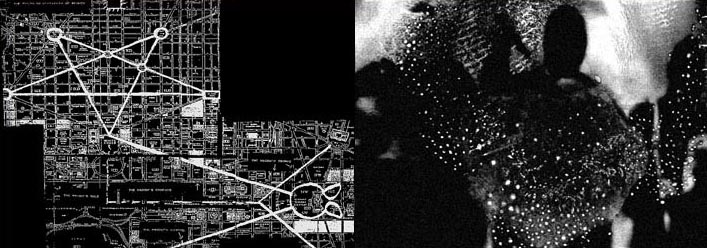
Ghost, bumper stickers, Camouflage Brussels, 2005.
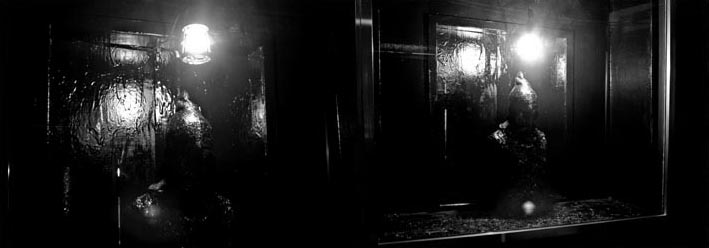
The sculpture of the hooded figure, which was to play a leading role in the exhibition We are them later in 2007.
For several years Gast Bouschet and Nadine Hilbert have been interrogating the world that surrounds them, and more specifically the social relations developed by mankind in different contexts. In their work The Trustfiles they show their interest for the profound perceptive crisis that characterizes our societies. How should we interpret the world? How can we develop our personalities? How can we define an identity in the abundance of models offered by our media-society? Bouschet and Hilbert are interested in the religious fervour as it is practized in the different continents, as well as in political and economic imperialisms.
In a vast diagram drawn on walls, they structure the consequences and the forms that those phenomena can take. The circular shape of the scheme and the impalpable character of the object (the ‘belief’, the ‘imperialisms’) are particularly adapted to the computer medium where interactive electronic files (including photographs, soundtracks, filmed sequences, extracts from chat rooms etc.) benefit an almost ‘divine’ ubiquity: they are likely to appear anywhere and at any time.
(Pierre-Olivier Rollin, catalogue text, Brussels-South, Krinzinger Projekte Wien, Austria, 2005)
Intervention at Krinzinger Projekte Wien, Austria, 2005
Depuis 2001, Gast Bouschet et Nadine Hilbert voyagent le monde et rapportent des images qu’ils ré-agencent et publient sur un site internet The Trustfiles.net archives tentaculaires qui ne cessent de grandir et font écho aux bruits de la planète. Interrogeant l’objectivité de la perception et la médiatisation du monde, leurs images politiques et poétiques mettent en garde contre les dérives de la société de surveillance, de l’Etat sécuritaire et de la forteresse Europe.
(Josée Hansen, Virdrun, pour une histoire de l’Art contemporain au Luxembourg, MUDAM Luxembourg, 2008)
Since 2001, Gast Bouschet and Nadine Hilbert have travelled round the world, bringing back images and sounds that they rearrange and upload onto the website The Trustfiles.net. tentacled archives that never stop growing and which echo the noises of the planet. Their political and poetic images question the objectivity of perception and the mediation of the world, warning against the tendency of the surveillance society, the security-obsessed State and fortress Europe.
(Josée Hansen, Virdrun, towards a history of Contemporary Art in Luxembourg, MUDAM
Luxembourg, 2008)
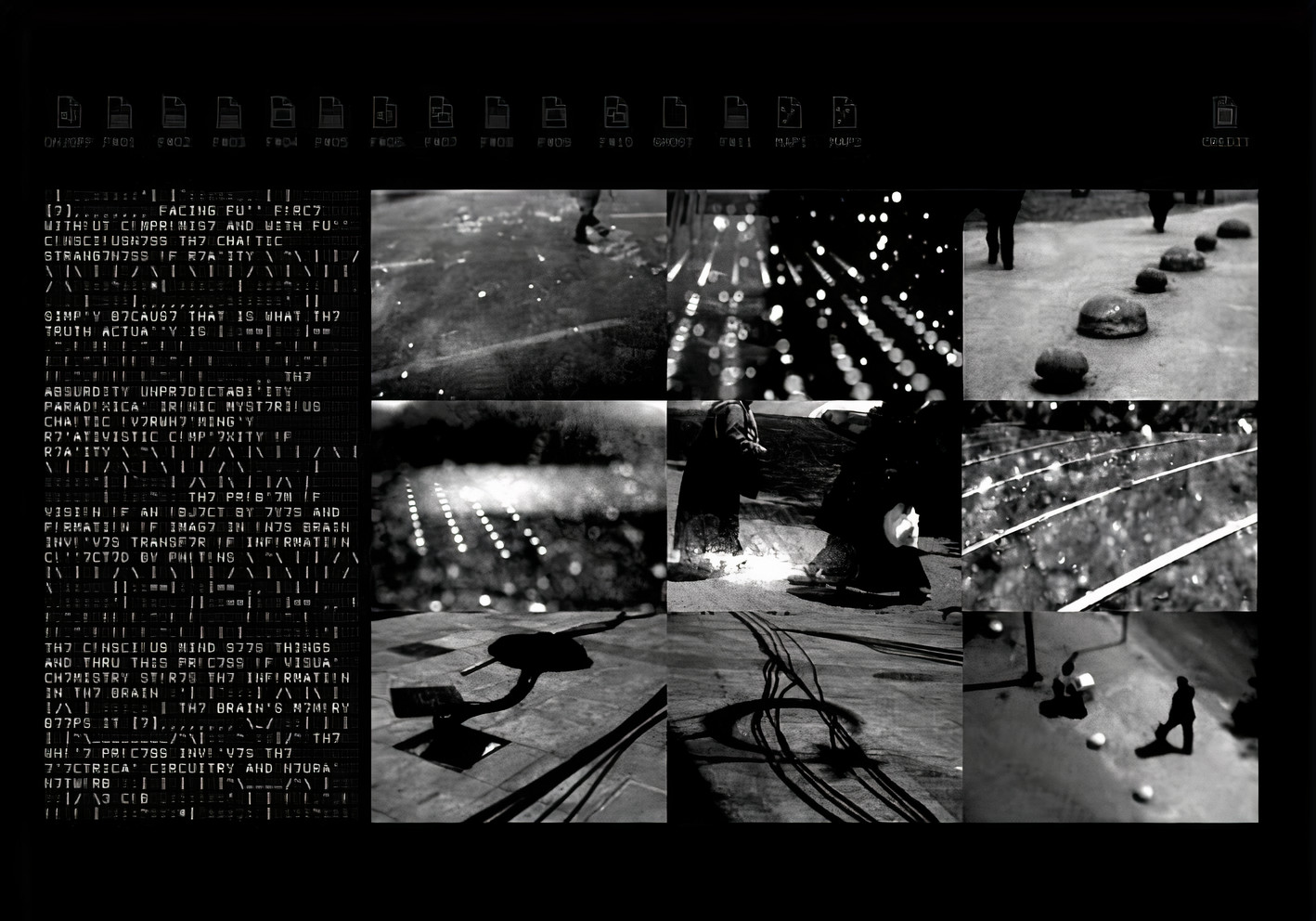
Cosmic Resonances, Istanbul 2004
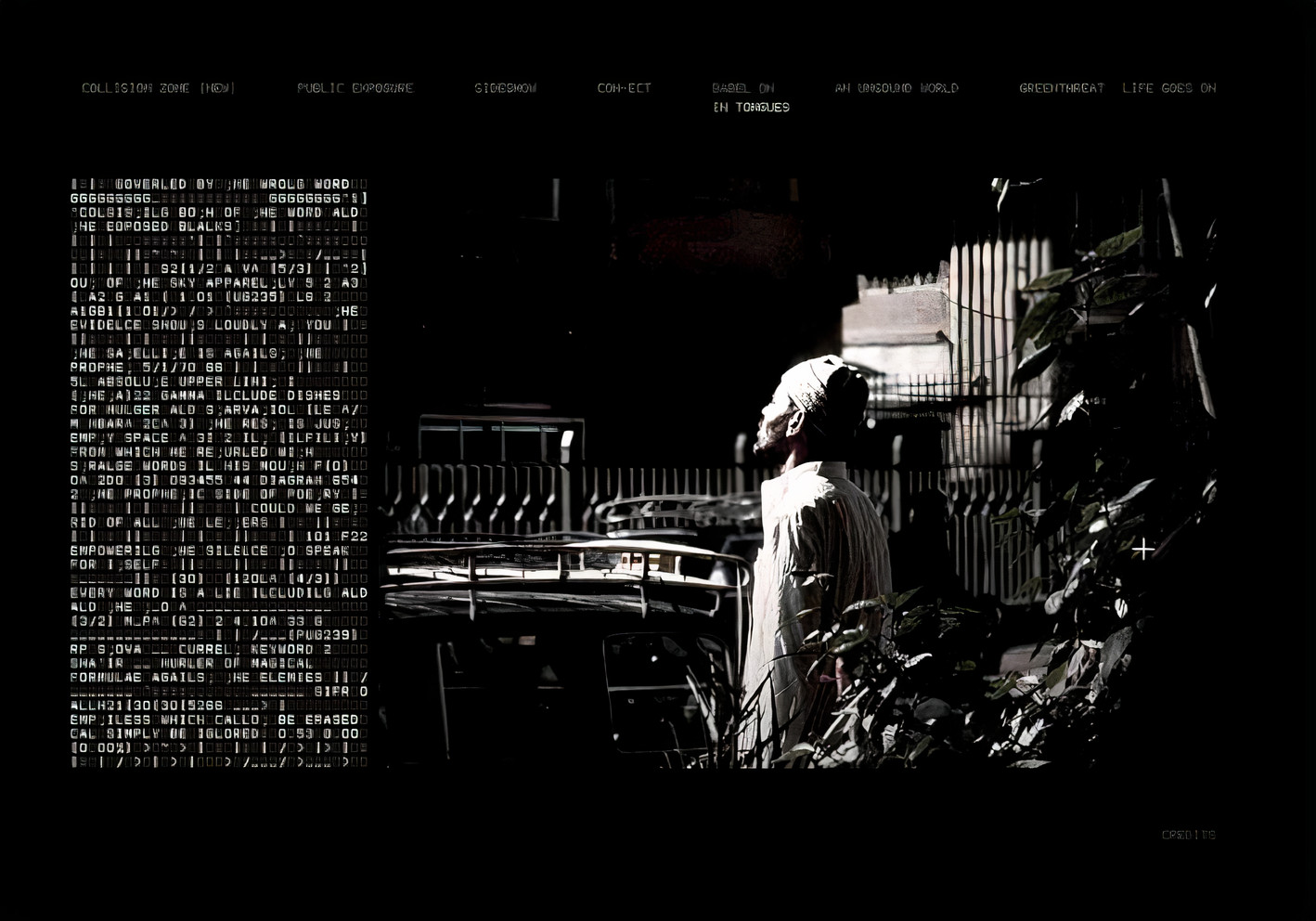
Satellites against the Prophet, Cairo 2003
SR-Medienkunstpreis 2002 an Gast Bouschet
Gast Bouschet erhielt am Dienstag dieser Woche in Saarbrücken die Auszeichnung für sein Multi-media Projekt ‘The Trust’, das im kommenden Jahr auch im Internet veröffentlicht werden soll. Es stützt sich auf dokumentarisches Fotomaterial, das er von seinen Reisen nach Ghana, Korea und in die Vereinigten Staaten mitgebracht hat. Man könnte ihn einen neuzeitlichen Nomaden nennen, der in diesem Jahr auch durch einen opulenten, klanggestützten Photo-essay über die urbanen Probleme Südafrikas hervorgetreten ist. Er richtet die Kamera auf sporadisch im öffentlichen Raum auftretende Zeichensysteme, die verborgene soziale Kontrolle und religiöse Überzeugungen signalisieren. Bouschets Photographien dokumentieren präzise bezeichnende Phänomene einer internationalen Uniformierung bzw. globalen Ent-Individualisierung. Der Begriff ‘Trust’ kritisiert ironisch sowohl aktuelle Aspekte der Globalisierung als auch triviale Äusserungen quasi religiöser Demonstrationen und Alltags-Embleme…
Bouschet’s Konzept erfüllt exemplarisch die Intentionen des SR-Medienkunstpreises, der insbesondere eine künstlerische Haltung fordert, die neue Beziehungs- und Handlungsfelder von Kunst als Vermittlerin zwischen Individuum und Informationsgesellschaft erschliesst… Der SR-Medienkunstpreis wurde zum dritten Mal vergeben… In diesem Jahr wurde er erstmals grenzüberschreitend ausgeschrieben und nahm Künstler aus Luxemburg, Ostfrankreich und dem Saarland in den Blick. Drei Nominatorenfür jeweils eine der drei Regionen benannten je vier Künstler(innen) unter denen die Jury dann den Preisträger auswählte. Nominator für Luxemburg war Enrico Lunghi vom ‘Casino Luxemburg – forum d’art contemporain’. Einzureichen waren Entwürfe für noch nicht realisierte Medienkunst-Projekte…
(Dr. Franz-Josef Reichert, Luxemburger Wort, 12 Dezember 2002)
Double screening based on The Trustfiles plus live music performance by Steve Kaspar and Andre Mergenthaler at Kufa Esch, Luxembourg, 2006
Transcript of a speech given by Prof. Bernd Schulz on the occasion of the SR-Medienkunstpreis 2002 Award attributed to The Trustfiles.
…There is this famous word by Baudrillard, concerning media… he speaks of the perfect crime. What he means is: we destroy reality by media… reality is completely disintegrated by this superficial and confused glance. This is a considerable action…. There’s something which the western media-world tends to suppress : namely that there’s magic to the photographed and filmed image… What do we actually see ? I believe that we see a sort of junction of two picture axes. One is the viewer’s, the artist’s one, but we see as well a picture axe coming from reality. Reality faces us through the picture, photography is nothing but the agent…at the same time, we get a glimpse into spaces which are in our heads. Let me cut a long story short at this point to speak to you about my meeting with the work of art of Gast Bouschet.
Several months ago, I saw a great piece of work by him:’ this space between us’, during the exhibition “Open House” in Luxembourg. He presented an installation, actually a slide-show, which put the visitor pretty much under stress. A slide-show is usually supposed to tell linear stories or organize the pictures around a basic theme. Contrary to all expectations, Gast Bouschet exposed us to a real crossfire of images. By doing so, he managed to create a tension in our perception, that made us consider why certain pictures produce a deja-vu experience and others don’t. What we saw and what immediately disappeared, was confronted to images inside our heads. You know, this collective unconscious… we all carry a part of this memory in our heads, it makes us compare everything that we see to this images in our heads. Gast Bouschet’s work heightens a very dense atmosphere, driving us to personal reflections, if we don’t escape or shudder.
Gast Bouschet developed this slide-and sound-show out of investigations in the scene of action. He spent some weeks in Johannesburg and its surroundings and shot pictures. We feel a link, a battle between rural spaces and those which are considered to be urban…this dissolution, this partly destruction of the rural space and the absorbing by a new urban space… But this is also our space, therefore we do feel quite attached and familiar. At the same time, we realize that this happens thousands of miles away and that there is probably more violence, than in our familiar urban spaces.
This is how Gast Bouschet succeeds in creating two attitudes in his work : one is making us feel quite related to human beings – he deals very discretely with the human figure he doesn’t invade them with his photography, he doesn’t bring them close. Their attitudes are more like mentioned. Yet he approaches them, by including their surroundings and he tells us in plain terms, that they are not that distant to us, bringing in this sort the familiar and the unknown together. In this context, it might be interesting to add a new interpretation to the ‘aura’ as Benjamin described it.
He deplored the loss of the aura in photography by its endless possibility of reproduction, for him the aura is a closeness/distance, that lightens up in the work of art. That’s why I believe, that a media artist such as Gast Bouschet demonstrates, that it is more then ever possible through the medium of photography, to restore the aura as closeness and distance which needs to be rediscovered.
There is another work of Gast Bouschet revealing these paradoxes of nearness and distance in the world of media… During the Kosovo war it could have been obvious for a journalist to travel to Kosovo to take images. Gast Bouschet moved in the opposite direction. He went to North America and filmed out of a car secret pictures of Wyoming. Why here, in the middle of the American rural heartland? Well… some hundred meters down below the ground there’s a nuclear shelter where the intercontinental missiles, as well as the commanding posts, that guided the missions of the troops in Kosovo war were installed. Gast Bouschet had a very close look at the surface of this area, which is strangely and paradoxically connected to this war. Up the ground, people were watching pictures of the Kosovo war, that took actually place in a very concrete sense below their feet. So he is a releaser of “picture machines”, which are evidently military according to Virilio. His work title “ listen to your holes “ is hard to understand, particularly since we do not have a relation to the tradition of miners. In the mines it was absolutely necessary to hear the approaching danger… if there were noises, which indicated danger. This endangering, that exists similarly and specially in our contemporary world, always close to war, has been switched together in a very dense form.
We awarded the price for a new project, this was the condition. It’s not about finished works… Trust plays certainly a role in our judging, this confidence that we put in an artist and his working methods. Gast Bouschet proposed a project, that is going to be seen on internet soon… and his working method, his investigations and accumulation of material will probably be quite similar to the already described projects. His work is also a reflection on travelling. Travelling is important to him, the artist lives quite a nomadic existence. He comes from Luxembourg, but doesn’t live in his homeland, he has moved to Brussels, and by doing so, he knew quite early in his life, what it means to be a foreigner. He travelled a lot, numerous countries, Korea, Ghana. – another African country… Africa: a huge continent, falling more and more into oblivion. Now and then we see pictures of war, or maybe some beautiful images from the Serengeti, but there is nearly nothing left of it in our collective picture memory… the media! … at least nothing concerning the present-day development of the last decades. So, Ghana and Korea as first destinations…
the project’s title is “ The Trustfiles“. It has a double meaning in the English language: it refers to the economical sector with its international entanglements. But it can also be applied to our old word ‘confidence’. That leaves us again with the question of confidence in pictures. Which pictures can we trust? Gast Bouschet has evolved into a specialist in decoding pictures… and the codes are not only inside the pictures but also in the real world. These aspects seems to inspire him more than anything else: to filter determined codes under determined perspectives. For this project, he keeps depicting and analyzing the codes, that our western culture has left on other cultures. We just need to watch these images to know what they are about. (loosely translated from German)
E SCHEINE CHAOS, CASINO FORUM D’ART CONTEMPORAIN, LUXEMBOURG, 2008
Lecture on The Trustfiles by Gast Bouschet & Nadine Hilbert
Communiqué de presse:
D’Kënschtler stellen unhand vu Projektiounen an enger Presentatioun vun hirer Websäit hir aktuell Aarbecht fir. Den Internetsite www.thetrustfiles.net ass en Netzwierk vu Fotoen, Videofilmer, Toun an Textfragmenter. Et ass e work in progress, deen d’Faszinatioun vum enregistréierte Bild als Rezeptor an Transformator vu subjektive Wouerechten erëmspigelt. Dem Nadine Hilbert a Gast Bouschet hir Konscht beschäftegt sech mat der déiwer perceptiver Kris, déi eis Gesellschaft duerchzitt, an hannerfreet d’Roll vun der medialer Berichterstattung als objektiv Instanz. Hir Experienzen demonstréieren e politescht a poetescht Engagement mat Multimedia a verbanne visuell Analys an intuitiv Interaktioun zu engem Wierk, dat der Villsäitegkeet an der Ambiguitéit vun der globaler Welt gerecht wëll ginn.
